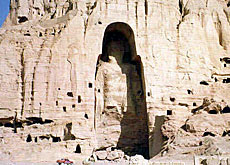Scientists construct 3D image of Bamiyan Buddhas

Scientists from the Federal Institute for Technology in Zurich have prepared a three-dimensional blueprint for reconstructing the Bamiyan Buddhas in Afghanistan.
The two giant statues, the tallest and oldest standing Buddhas in the world, were destroyed by the former Taliban regime in 2001.
Professor Armin Grün and his assistant Fabio Romondino recently spent almost a week in the Bamiyan valley, taking measurements and gathering information on how the 55 and 38-metre-high statues could be rebuilt.
With the help of a global positioning system (GPS) and homemade markers, scientists have created a 3D computer image of the niches and the whole cliff, which measures more than one kilometre in length.
“It is not only a matter of reconstructing the statues, we also have to fix the whole rock around them. The rock was damaged by the explosion, and at the moment there is some rockfall and it is a bit dangerous,” Grün told swissinfo on his return from Afghanistan.
Built by monks
Grün estimates that it would cost between $30-50 million (SFr40-65 million) to reconstruct the statues, which were carved by Buddhist monks more than 1,800 years ago.
And while some might question such an expensive project at a time when the shattered country still requires vast amounts of aid, he argues that many Afghans are in favour of such a project.
“I had the chance to talk to many Afghan people, the local governor of Bamiyan and the vice-president of Afghanistan, and all of them really expressed a great interest to have the Buddhas reconstructed,” added Grün.
However, the final decision on whether to invest money in the revival of the giant Buddhas rests with the government.
Afghan support
Grün says he is hopeful that politicians will endorse such a scheme, since the country’s vice-president, Karim Khalili, is one of the strongest supporters of the project.
“If the world is really serious about fighting terrorism, it should be equally serious about reconstructing objects that were destroyed by terrorists,” Khalili told an Afghan press conference earlier this month.
Paul Bucherer from the Afghanistan museum in the Swiss village of Bubendorf agrees with Khalili, and argues that there is money available that is not intended for humanitarian aid.
“We must not spend a penny of the money set aside for humanitarian aid on the reconstruction of the Buddhas,” he said.
“But there are funds that are not intended for humanitarian projects, which we could tap into for this project.”
“If we consider the Buddhas to be a tourist attraction generating income for the valley, we could be seen as helping people to help themselves.”
swissinfo, Billi Bierling and Joanne Shields
Buddhist monks carved the Bamiyan Buddhas more than 1,800 years ago.
The two great statues were 55 and 38 metres tall.
The former Taliban regime destroyed the Buddhas in March 2001.

In compliance with the JTI standards
More: SWI swissinfo.ch certified by the Journalism Trust Initiative








You can find an overview of ongoing debates with our journalists here . Please join us!
If you want to start a conversation about a topic raised in this article or want to report factual errors, email us at english@swissinfo.ch.